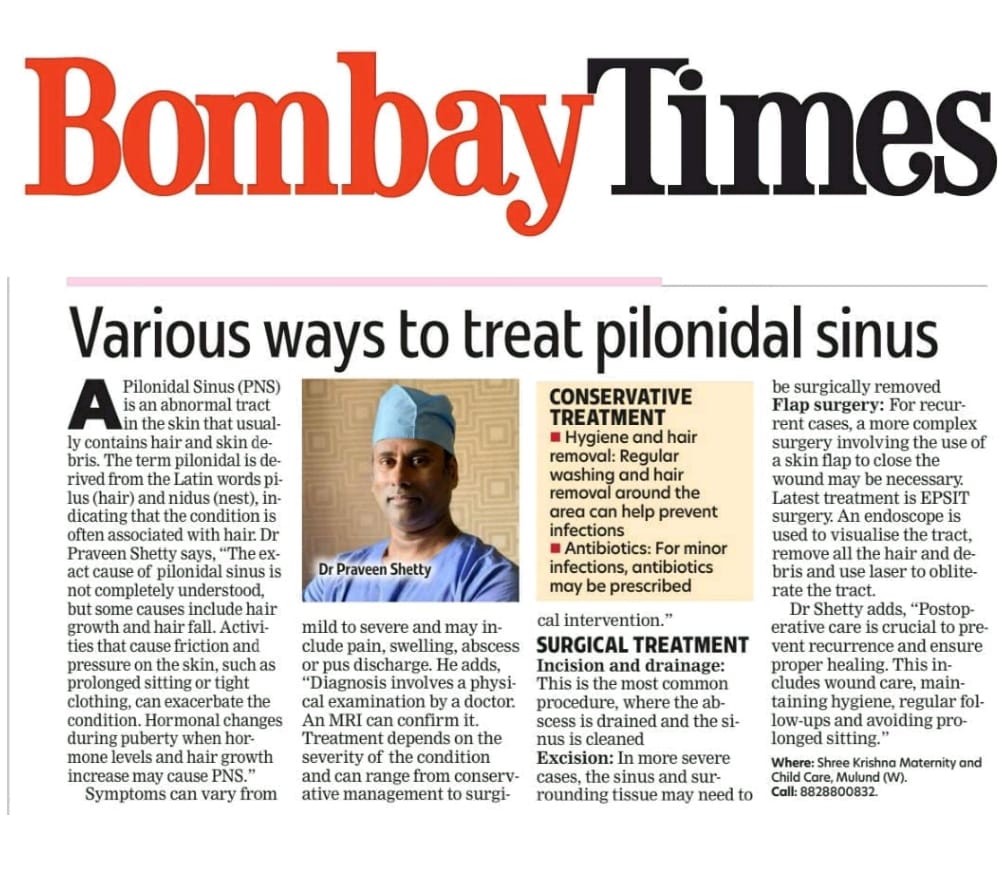
| Speciality | Advanced Laparoscopic Procedures |
| Degrees | MBBS & M.S (General surgery) (Mumbai) Diploma advanced Laparoscopy (bordeaux france) FIAGES |
| Areas of Expertise |
|
| Gender | Male |
Dr. Pravin Shetty
Advanced Laparoscopic Procedures
A pilonidal sinus (PNS) is an abnormal tract in the skin that usually contains hair and skin debris. The term "pilonidal" is derived from the Latin words for "hair" (pilus) and "nest" (nidus), indicating that the condition is often associated with hair.
Causes
The exact cause of pilonidal sinus is not completely understood, these are some of them
- Hair Growth and hair fall
- Friction and Pressure:
Activities that cause friction and pressure on the skin, such as prolonged sitting or tight clothing, can exacerbate the condition.
- Hormonal Changes:
It often occurs during puberty when hormone levels and hair growth increase.
The symptoms of a pilonidal sinus can vary from mild to severe and may include:
The symptoms of a pilonidal sinus can vary from mild to severe and may include:
Pain,swelling ,abscess or pus discharge
Diagnosis
Diagnosis typically involves a physical examination by a doctorf . MRI can confirm it.Treatment
Treatment for pilonidal sinus depends on the severity of the condition and can range from conservative management to surgical intervention.
Conservative Treatments
- Hygiene and Hair Removal:
- Antibiotics:
Surgical Treatments
- Incision and Drainage:
This is the most common procedure, where the abscess is drained, and the sinus is cleaned.
- Excision:
In more severe cases, the sinus and surrounding tissue may need to be surgically removed.
- Flap Surgery:
For recurrent cases, a more complex surgery involving the use of a skin flap to close the wound may be necessary.
Latest treatment is EPSIT surgery. Where a endoscope is used to visualise the tract remove all the hair and debris and use LASER to obliterate the tract it is minimal invasive surgery with excellent results , minimal pain and early return to activity.
Postoperative Care
Postoperative care is crucial to prevent recurrence and ensure proper healing. This includes:- Wound Care:
,maintaining hygiene ,regular follow ups and avoiding prolonged sitting.
- Prevention
Maintain Good Hygiene,avoid prolonged sitting
A pilonidal sinus is a manageable but often painful condition that can significantly impact quality of life if not treated properly. Understanding the causes, recognizing the symptoms, and seeking appropriate treatment can help manage and prevent this condition. Regular hygiene, hair removal, and avoiding prolonged sitting are key preventive measures to reduce the risk of recurrence.Dr. Pravin Shetty
Advanced Laparoscopic Procedures
Mulund West
Shreekrishna maternity and child care
